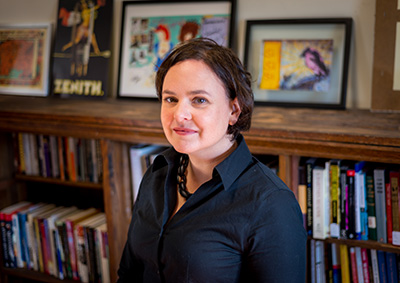
Bridging the Waves of Feminism: Sonic Women Performers of the Mid-20th Century
In 1949 Simone de Beauvoir opened her classic feminist existentialist text, The Second Sex, with the question, “What is a woman? Is she her “womb,” her female body, Beauvoir wondered, or is she an idea, a Platonic ideal or essence?
Ultimately, Beauvoir argued that women are not born women, despite their female physiology, but become women over the course of living. In my current research of all-girl sonic culture in mid-20th century America, I apply Beauvoir's question and premise to American media culture and look for clues about the construction of the collective category “women” at that time, and how this construction anticipated and engaged with the second-wave feminist movement.
Explanations, interpretations and histories of American feminism most often use the metaphor of the wave to identify the ebbs and flows of activism around gender oppression.
The first wave is generally understood as the feminism of the late 19th to early 20th centuries and encompasses the activists who fought for women's full participation in politics and public life, and to end male domination and female oppression. This first wave of feminism culminated with women's suffrage in 1920.
The second wave, drawing from the work of the first and expanding its critique and analysis, began in the early 1960s. Popular texts such as Betty Friedan's The Feminine Mystique were important catalysts and generated the rallying cries of “the personal is political” and “sisterhood is powerful.” Women worked together to raise consciousness about what it meant to be a woman, instigated research agendas around gender and changed our political systems to be more inclusive.
Looking for cultural antecedents to the development of a collective female subject necessary for political activism, I turn to the popular culture in those dormant decades between the first and second waves of feminism. In popular culture we share in the construction and development of gender norms and ideals. Popular culture helps teach us how to be women and men, and it captures our deepest ambivalences about changes in these identities. I always tell students that to get a sense of societal norms and expectations about any given topic, just turn on the television, the radio (and now, the Internet) and check out which stories we are telling ourselves.
The thriving “all-girl” music culture that took shape in the 1940s, '50s,and '60s offers one site of collective female experience in popular culture. From orchestras and jazz bands to R&B “girl groups” and the occasional all-girl radio station, women worked together as performers who acted out visions of femininity in addition to music. These were novelty acts to be sure, but they were also sites of rich gender construction that captured the multiplicity and diversity of “woman” and led to the development of the collective female subject necessary for political activism.
Consider the ambivalence captured by Marilyn Monroe in Billy Wilder's 1959 comedy Some Like it Hot. As Sugar Kane, the ukulele player and singer for an all-girl jazz band, Monroe is both beauty and brains. She is career woman and lost girl; she is witty and outwitted. When she sings the 1920s tune “I Wanna Be Loved by You” in a startlingly suggestive gown, she is both ingénue and well-tread professional, and we can't quite believe her when she claims she “couldn't aspire to anything higher.”
In my research of all-girl sonic media of the mid-20th century, I look at these musical acts and radio stations to understand the culture that articulated and anticipated the feminist movement that was to follow. These collective identities of women amplified women's voices and highlighted differences among women, as well as their need for cooperation and empowerment. These women in the all-girl acts did, in fact, aspire—and to much, much higher.
-Melissa Meade, Associate Professor, Humanities
An essay by Professor Meade that grew out of her research will be published in 2014 as a chapter in the book Representing Women's Intellect in Film and Television (Scarecrow Press).


